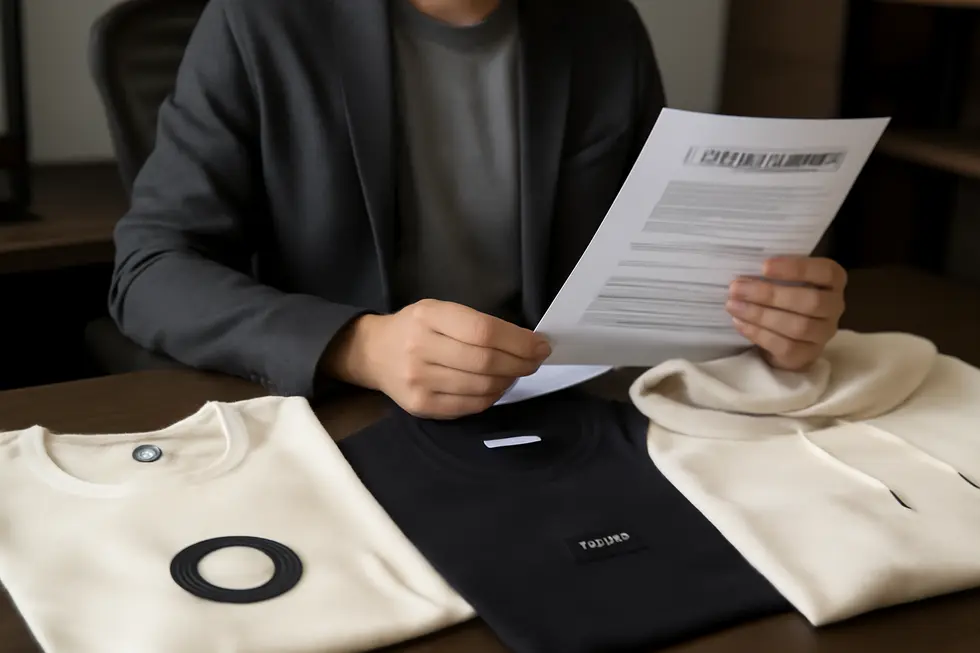Introduction
Building a clothing brand goes beyond creating stylish apparel; it demands protecting the identity and creative elements that define your business in the marketplace. For business owners, understanding how copyright and trademark laws intersect in the fashion industry is vital to securing your brand and avoiding costly infringements. Trademark law forms the legal backbone safeguarding your brand’s name, logo, and distinguishing marks, while copyright offers limited but crucial protection for original artistic expressions such as unique fabric prints. This comprehensive guidance explores trademark protection as the foundation of your copyright clothing brand, the nuanced role copyright plays in creative elements, and branding strategies coupled with legal considerations every entrepreneur must navigate. Together, these aspects will empower you to confidently establish and defend your brand’s presence in the competitive apparel market.
Tables of Contents
Chapter 1: Trademark Protection in Copyright Clothing Brand: Legal Foundation and Importance
- Establishing Exclusive Rights and Combating Infringement: The Legal Backbone of Trademark Protection for Clothing Brands
- Safeguarding Brand Identity and Consumer Confidence Through Trademark Enforcement in Fashion
Chapter 2: Role of Copyright in Protecting Creative Elements of Copyright Clothing Brand
- Navigating Legal Boundaries and Emerging Tech Challenges in Safeguarding Fashion Creativity
- Economic and Societal Dimensions of Copyright Protection in Fashion Branding
Chapter 3: Strategic Branding and Legal Foundations for Copyright Clothing Brand Entrepreneurs
- Integrating Intellectual Property Protections with Business Formation to Secure Your Clothing Brand’s Identity
- Navigating Co-Branding and Fair Use Complexities in Trademark Protection for Clothing Brands
Chapter 1: Trademark Protection in Copyright Clothing Brand: Legal Foundation and Importance

1. Establishing Exclusive Rights and Combating Infringement: The Legal Backbone of Trademark Protection for Clothing Brands
Trademark protection serves as the cornerstone for safeguarding a clothing brand’s unique identity in a crowded marketplace. At its core, trademark law grants clothing brands exclusive rights to distinctive identifiers—such as names, logos, slogans, and specific design elements used in commerce—that distinguish their products from competitors. These exclusive rights primarily arise through federal registration with the United States Patent and Trademark Office (USPTO), which confers nationwide protection and the ability to use the ® symbol, indicating a federally registered trademark. Even without registration, common law rights may afford some protection based on actual use in commerce; however, these are geographically limited and generally weaker than registered trademarks.
For a clothing brand’s trademark to qualify for protection, it must be distinctive. This means it cannot be generic or merely descriptive unless it has developed a secondary meaning sufficiently recognized by consumers as identifying a particular source. For example, coined or fanciful brand names, unique logos, or stylized fonts associated specifically with a brand are protectable. This distinctiveness helps consumers reliably identify the origin of apparel products, fostering brand loyalty and trust.
Infringement occurs when another party uses a mark that is identical or confusingly similar to the protected trademark in a way that might mislead consumers about the source of garments or related goods. This can encompass direct copying of logos or brand names, as well as deceptive imitation of unique stylistic features such as packaging, tag designs, or color schemes that consumers associate with the original brand. Crucially, infringement hinges on commercial use—personal or non-commercial use rarely qualifies, unless it risks confusing the buying public.
When trademark infringement is established, the law offers several remedies to the owner. These include injunctions that can prohibit further unauthorized use, monetary damages to compensate for lost revenue or harm to reputation, and orders to destroy counterfeit or infringing materials. In cases demonstrating willful infringement or bad faith, courts may also award attorneys’ fees. However, trademark rights are not self-enforcing; brands must actively monitor the marketplace and enforce their rights promptly. Neglecting enforcement can lead to dilution of rights or loss through genericization, where a trademark becomes synonymous with a product category (e.g., escalator).
International aspects further complicate protection for fashion brands operating globally. For example, U.S. courts apply the “doctrine of foreign equivalents,” translating foreign-language marks into English to assess distinctiveness and likelihood of confusion. This affects brands with foreign names seeking U.S. trademark registration, necessitating careful strategic consideration during application to avoid rejections or conflicts.
There are limited statutory exceptions, such as fair use and parody. These allow some non-trademark uses for commentary or critique when no consumer confusion arises. However, these defenses are narrowly drawn and fact-specific, requiring thorough legal analysis before relying on them.
It’s important to distinguish trademark protection from copyright law in the fashion context. Trademark targets brand identifiers that signal product origin, while copyright protects original artistic works—like unique textile prints or graphic designs—rather than brand names or logos themselves. Thus, many clothing brands complement their trademark registrations with copyright protection where applicable but rely mainly on trademarks for enforcing exclusive brand rights.
For entrepreneurs launching clothing lines via private-label or white-label manufacturing, rigorous trademark registration and vigilant enforcement remain paramount to legally assert and defend their brand identity. This foundational legal protection ensures the ability to build consumer recognition without the threat of confusing imitations undermining brand value.
For practical guidance on trademark registration and protection strategies tailored to the fashion industry, resources such as Trademark2Go’s trademark services provide valuable, specialized insight. Leveraging these expert tools empowers clothing brands to secure their exclusive rights effectively and navigate the complex legal landscape underpinning apparel branding.
This legal framework forms the bedrock upon which robust trademark protection stands, enabling clothing brands to maintain market distinction, prevent infringement, and safeguard their intellectual property in a highly competitive field.
2. Safeguarding Brand Identity and Consumer Confidence Through Trademark Enforcement in Fashion
Trademark protection forms the backbone of a clothing brand’s ability to establish and maintain a strong identity in a crowded marketplace. Unlike copyright, which offers limited protection mainly to artistic fabric prints but rarely to apparel designs themselves, trademark law secures exclusive rights to elements that consumers rely on to distinguish one brand from another. These elements include brand names, logos, and distinctive design features that serve as a visual shorthand for the brand’s reputation and quality. Without reliable trademark protection, the unique identifiers helping consumers recognize and trust a clothing line can be copied or diluted by competitors, which undermines the brand’s position and value.
Protecting these brand identifiers is not merely a legal formality—it directly impacts consumer trust. When shoppers see a registered trademark symbol (®) or even a common law trademark indicator (™), it signals that the brand is committed to quality and authenticity. This assurance reduces confusion in the marketplace and helps consumers confidently select genuine products. The presence of a strong trademark also facilitates brand loyalty, as customers come to associate the symbol and name with positive experiences. Conversely, if inferior imitations flood the market under a similar name or logo, consumer confidence erodes, hurting legitimate sales.
Maintaining this protection requires diligent enforcement. Trademark owners must actively monitor and challenge unauthorized usage, which can appear across physical retail outlets, e-commerce platforms, and increasingly, digital channels such as social media and influencer collaborations. Without this vigilance, infringements multiply, blurring distinctions between genuine and counterfeit goods and diminishing the original brand’s strength. Enforcement involves legal action when necessary but also prudent strategies like cease-and-desist letters and strategic partnerships to control brand use.
On the international stage, brand protection grows more complex but equally essential. Since trademark rights are generally territorial, securing registrations in each country where the clothing brand operates is critical. This localized protection empowers the brand to prevent infringement and counterfeit activity in key markets. International agreements, notably the Madrid Protocol, streamline this process by allowing a single application to extend protection to multiple jurisdictions, simplifying global brand management. For clothing brands with aspirations beyond their home market, leveraging these tools ensures their identity—and the consumer trust it embodies—translates across borders.
This comprehensive approach to trademark protection safeguards more than just a mark on a label; it preserves the very essence of the brand’s market presence and competitive edge. It empowers clothing brands to stand out authentically, build enduring customer relationships, and defend their reputation from unauthorized exploitation worldwide.
For entrepreneurs unsure whether their brand elements qualify for trademark protection or how to initiate the process, resources explaining when and why businesses need trademarks can provide valuable insights. More detailed guidance on trademark protection and enforcement tailored for clothing brands is available from authoritative sources such as UpCounsel’s overview on trademark and label protection.
Chapter 2: Role of Copyright in Protecting Creative Elements of Copyright Clothing Brand

1. Navigating Legal Boundaries and Emerging Tech Challenges in Safeguarding Fashion Creativity
In the complex landscape of intellectual property law, protecting the creative elements of a clothing brand requires a nuanced understanding of the distinct roles copyrights and trademarks play, especially as technological advancements reshape the industry. While copyright law provides a foundation for guarding original artistic expressions on apparel, such as unique textile prints or graphic designs, it stops short of covering the garment’s three-dimensional shape or general appearance under U.S. law. This limitation means that many fashion brands lean heavily on trademark and related protections to defend their market identity and creative investments.
Copyright protection arises automatically once an original work is fixed in a tangible form, encompassing vivid patterns, artwork, or prints used on fabric. However, the threshold for copyright eligibility is originality and creativity; simple clothing constructions or common patterns usually do not qualify. For example, Missoni’s distinctive zigzag knit pattern has stood up in court as protected artistic expression, illustrating how copyright can guard intricate fabric designs but not the clothing’s physical contours. The duration of this protection extends through the creator’s lifetime plus seventy years, providing long-term security for such original elements.
Conversely, trademarks serve as the critical vehicle for protecting brand identifiers that consumers associate with quality and style. This includes logos, brand names, and even distinctive design features—such as Adidas’ three stripes—which act as source indicators rather than purely decorative elements. Trademark protection requires registration to maximize enforceability, granting exclusive rights to prevent others from using confusingly similar marks on apparel. High-profile cases, like the dispute involving Adidas’s stripes and Forever 21, demonstrate how even seemingly simple design components can achieve legal protection once they acquire distinctiveness linked to a brand’s reputation. Such protections are vital for combatting counterfeiters who often copy recognizable branding to mislead customers.
The legal system in the United States does not afford explicit design rights that cover the overall shape or cut of garments, a gap that challenges brands seeking to prevent imitators copying the silhouette or construction of popular apparel. Some companies have attempted to navigate this gap through creative application of existing intellectual property laws by focusing on specific garment features—such as unique seam placements or embellishments—that may be eligible for trademark or trade dress protection. This tactical use of multiple IP frameworks underscores the fragmented nature of legal protections in the fashion sector and the need for strategic brand management.
Adding to the complexity is the rise of generative artificial intelligence (AI) in fashion design. AI tools can autonomously generate new patterns or design ideas based on data that may include copyrighted works, raising thorny questions about copyright infringement and originality. Current legal interpretations, especially within the EU and UK, suggest that AI-generated designs modified by human creativity could qualify as new, non-infringing works. Still, the evolving interaction between AI capabilities and intellectual property law presents ongoing challenges for clothing brands striving to protect their unique creative elements amid rapid technological change.
Together, these legal and technological dynamics require clothing brands to adopt a layered approach to intellectual property protection. Leveraging copyright to defend original artistic prints, while vigorously securing trademarks for brand identifiers, forms the backbone of a strong protection strategy. At the same time, brands must remain vigilant and adaptable to emerging issues such as AI-generated designs and persistent gaps in design shape protections.
For brands considering the launch or expansion of their apparel lines, ensuring the proper registration of trademarks early is essential to safeguard brand distinctiveness and gain nationwide enforcement rights. Exploring how creative elements fit within the existing legal framework—and monitoring evolving technology-related developments—can empower brands to better protect their identity and innovation against infringement.
For further insight on how trademarks serve as a cornerstone for protecting brand identity in clothing, see this resource on trademark essentials for businesses. Moreover, the detailed analysis of design protection challenges in the apparel industry showcases the importance of strategic IP management: https://news.law.fordham.edu/blog/2025/08/11/bloomberg-prof-susan-scafidi-lululemon-costco-suit-show-economy-is-ripe-for-fake-and-copycat-goods/
2. Economic and Societal Dimensions of Copyright Protection in Fashion Branding
Copyright protection plays a pivotal role in maintaining the economic vitality and cultural integrity of clothing brands by safeguarding original creative works embedded in apparel. While trademark law shields brand names and logos, copyright specifically preserves unique artistic expressions, such as intricate textile prints or highly creative design elements. This legal protection is crucial not only for preventing unauthorized duplication but also for fostering an environment where innovation can thrive.
Economically, copyright offers designers and brands the exclusive rights to their original creations, deterring counterfeiters who undermine both revenue and reputations. When counterfeit products flood the market, they dilute brand identity and diminish legitimate sales, causing significant financial losses that ripple through the entire industry. For example, celebrated designers who have successfully sought injunctions against infringement illustrate how copyright enforcement can halt unauthorized copying that threatens their commercial interests. By ensuring creators can reap the benefits of their ingenuity, copyright incentivizes continued investment in fresh designs and artistry, ultimately fueling the fashion sector’s growth.
The societal impact of copyright extends beyond economics to shape the cultural landscape of fashion. Legal protection for creative elements nurtures a culture of originality and respect for intellectual property. It motivates designers to push creative boundaries rather than resorting to imitation, fostering diversity within styles and ideas. Yet, enforcement challenges remain as some brands prioritize expansion over rigorous intellectual property strategies, sometimes lacking the resources to combat infringement effectively. Additionally, the rise of digital fashion and virtual assets introduces novel considerations, requiring evolving IP protections to address creative works that exist solely in online platforms. This evolution highlights copyright’s expanding role in safeguarding artistic endeavors across emerging formats.
Legally, courts acknowledge the fine line between inspiration and originality in fashion design. Even when designs draw from existing styles, they can qualify for copyright protection if they demonstrate sufficient creative independence and distinctiveness. This balance ensures that the realm of applied arts recognizes genuine craftsmanship without stifling creative influence, allowing designers to build upon prior traditions while securing their unique contributions.
Market dynamics introduce further complexity by spotlighting “dupes” — affordable alternatives that mimic high-end fashion looks without directly infringing copyright. These products often provoke debate about consumer access versus brand dilution. While dupes may not always breach legal boundaries, they challenge perceptions of exclusivity and the value attached to original creations. Some luxury brands tolerate or indirectly benefit from the social buzz these copies generate, reflecting how consumer aspirations interact with intellectual property protections.
Together, these economic and societal forces underscore the indispensable role of copyright frameworks in sustaining both the commercial viability and cultural significance of clothing brands worldwide. Protecting creative elements preserves not just income streams but also the artistic spirit that drives fashion forward.
For entrepreneurs building apparel brands, understanding the interplay between copyright and trademark protections is fundamental. While trademarks secure brand identifiers, copyright complements by covering original artistic expressions that trademarks cannot. Those interested in the foundational steps for trademark protection might find valuable guidance by exploring resources such as this trademark registration guide.
Further insights into the expanding scope of intellectual property in fashion, including challenges posed by virtual garments and evolving legal precedents, continue to shape how creators defend their work in a highly competitive industry.
Chapter 3: Strategic Branding and Legal Foundations for Copyright Clothing Brand Entrepreneurs

1. Integrating Intellectual Property Protections with Business Formation to Secure Your Clothing Brand’s Identity
Building a clothing brand that stands out in an intensely competitive market demands a thoughtful blend of creative branding and solid legal foundations. For entrepreneurs entering the apparel world, the intersection of intellectual property (IP) protection and structured business formation is crucial to sustaining and defending brand identity. Establishing distinctive visual elements—such as logos, brand names, and unique textile prints—is not just a marketing priority but a key component of legal strategy.
Copyright law plays a specialized yet limited role within the fashion industry. While basic garment shapes or common patterns do not qualify for copyright protection, truly original artistic expressions like custom fabric prints and intricate textile designs can receive copyright safeguards. This protection secures the creative artwork behind the fabric but does not extend to the functional aspects of clothing. For example, a unique knit pattern might be copyrighted, but the overall shape of a shirt typically cannot. This nuance helps entrepreneurs understand where originality in design can yield exclusive rights.
More broadly, trademarks offer comprehensive protection for the elements most critical to brand recognition. Brand names, logos, slogans, and even distinct fonts uniquely associated with your clothing line serve as identifiers of origin in the marketplace. Early and proactive trademark registration with the United States Patent and Trademark Office (USPTO) secures nationwide rights, enabling entrepreneurs to prevent counterfeiters and unauthorized users from exploiting brand goodwill. Using trademark symbols—™ for pending registrations and ® for federally registered marks—reinforces ownership and deters infringement.
Alongside trademarks and copyrights, trade dress protection plays an important, though often overlooked, role. Trade dress refers to the visual appearance that signals to consumers a product’s source, encompassing the overall look and feel of packaging or even apparel, if it is non-functional and distinctive. Securing trade dress rights requires proving acquired distinctiveness and nondisruptiveness to competition but can provide powerful protection if the brand’s aesthetic itself becomes a premium asset. Famous examples include color schemes or packaging designs strongly linked to a single brand.
Entrepreneurs must balance aggressive protection with ethical and legal considerations. Avoiding infringement requires diligent research to ensure designs and branding do not conflict with existing rights. Overreaching claims to IP can backfire, potentially alienating customers or inviting legal challenges that detract from brand building. Additionally, sensitivity toward cultural elements is essential; collaborating with local artists and acknowledging inspirations prevents appropriation claims and fosters authentic brand stories.
Strategically, the legal protection of intellectual property is deeply intertwined with how the clothing brand is structured as a business. Forming a legal entity such as a limited liability company (LLC) or corporation provides separation of personal and business liabilities. This separation is vital when entering into licensing agreements, securing contracts with manufacturers, or assigning IP rights. Proper business formation facilitates clear ownership of trademarks and copyrights, simplifying enforcement actions if infringement occurs.
Consulting with attorneys specializing in intellectual property and business formation right from the startup phase ensures branding strategies align with legal safeguards and commercial goals. Such expert guidance helps entrepreneurs navigate registration processes, maintain compliance, and leverage IP as a valuable business asset.
Ultimately, a clothing brand’s long-term success depends on intertwining creative expression with a robust legal framework. By fusing immaculately crafted branding with early intellectual property registration and prudent business formation, entrepreneurs create defensible, marketable, and sustainable labels. This careful foundation protects innovation, enhances reputation, and strengthens competitiveness in the dynamic apparel industry.
For further detailed insights on navigating intellectual property within fashion business structures, entrepreneurs can explore the comprehensive overview provided by IP Works Law.
2. Navigating Co-Branding and Fair Use Complexities in Trademark Protection for Clothing Brands
For clothing brand entrepreneurs, establishing a strong brand identity involves more than just crafting appealing designs—it demands strategic legal planning around trademarks, co-branding partnerships, and intellectual property risks. Trademark protection remains the cornerstone of safeguarding a brand’s unique identifiers, such as its name, logo, slogan, and distinctive design elements like signature colors. While copyright can sometimes shield original textile prints or artistic fabric patterns, its scope in apparel is limited. Therefore, entrepreneurs must prioritize securing trademark registrations with the USPTO to gain exclusive rights and legal tools to combat counterfeit products and brand dilution.
When entering co-branding arrangements, clear and detailed licensing agreements become indispensable. These contracts define each partner’s rights and responsibilities concerning the use of trademarks on collaborative products. A well-crafted agreement spells out the geographic scope, product categories, and duration for trademark use while addressing exclusivity or joint ownership. Such clarity minimizes risks of misuse or conflicts that could weaken brand value. Moreover, flexibility balanced with protection is vital to enable innovation and effective marketing collaboration without litigation risks.
Active enforcement of trademark rights is just as crucial as registration. Entrepreneurs should use modern tools like digital asset management systems combined with image recognition technologies to monitor unauthorized trademark use across online platforms and physical markets. This vigilance allows early detection of infringements or counterfeit operations. At the same time, understanding the nuances of copyright is important, especially since many garment designs may not qualify for copyright protection unless they exhibit sufficient originality. Fashion brands must approach the concept of fair use cautiously. Incorporating elements inspired by other creators, even when labeled as homage or parody, can trigger legal challenges due to the limited scope of fair use in commercial fashion contexts.
To navigate these complexities effectively, consulting specialized legal counsel is advisable. Lawyers can tailor trademark licensing agreements that align with business goals while anticipating disputes and enforcement strategies. Additionally, they provide guidance on managing the delicate balance between inspiration and infringement risks inherent in the fashion industry’s creative process. Alongside legal measures, forming the business entity appropriately—often as an LLC—provides liability protection and streamlines intellectual property management.
Ultimately, successful branding for clothing entrepreneurs hinges on a comprehensive approach: registering and enforcing trademarks, negotiating sound co-branding licenses, leveraging technology to safeguard brand assets, and understanding intellectual property boundaries including copyright and fair use. This multifaceted strategy not only protects the brand’s identity but also fosters fruitful partnerships and sustainable growth within the highly competitive fashion marketplace.
For more detailed guidance on trademark registration and protection strategies vital to fashion entrepreneurs, visit Trademark2Go’s resource on trademark needs.
Additional insights on co-branding agreements and licensing intricacies can be found in the comprehensive analysis provided by the PatentPC blog on trademark licensing for co-branding opportunities: https://patentpc.com/blog/how-to-use-trademark-licensing-for-co-branding-opportunities
Final thoughts
For business owners launching or growing a copyright clothing brand, mastering the interplay between trademark and copyright protections is key to building lasting market presence. Trademarks safeguard the vital brand identifiers that differentiate your products and foster customer loyalty nationwide, while copyright extends limited but meaningful protection for unique creative assets like fabric prints. Coupling these legal tools with thoughtful branding strategies ensures your fashion line stands on solid legal ground, giving you confidence to innovate without fear of infringement. Ultimately, investing in the protection of your intellectual property is not just a legal formality—it is the foundation of your brand’s long-term success and resilience in a competitive industry.
Your IP is the foundation of your success – let’s protect it together before it’s too late. We can’t wait to help you turn your ideas into legally secured assets.
About us
undefined



Can you be more specific about the content of your enticle? After reading it, I still have some doubts. Hope you can help me.
Thanks for sharing. I read many of your blog posts, cool, your blog is very good. https://accounts.binance.com/es/register?ref=RQUR4BEO
I don’t think the title of your article matches the content lol. Just kidding, mainly because I had some doubts after reading the article.